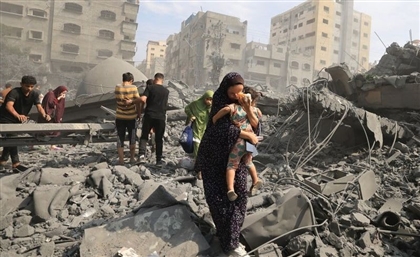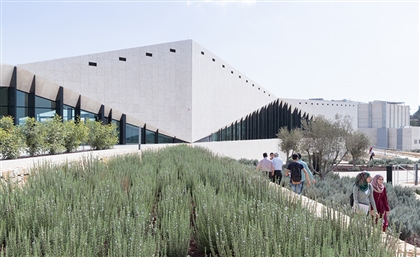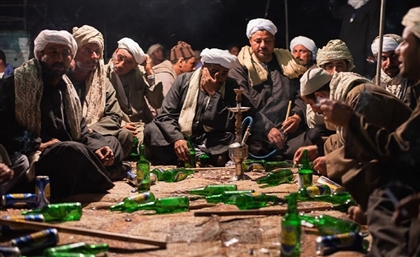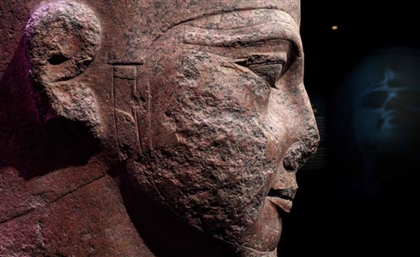Apartheid Art: The Stories Behind Striking Palestinian Graffiti
The omnipotent wall that reinforces the occupation of the West Bank serves as an artist's blank canvas, to various ends.

The West Bank Wall cuts through families, communities, and commute routes, inflicting a spatial violence and segregation that essentially makes it an apartheid wall, not merely a 'separation barrier.' Though the wall is illegal under international law, according to the International Court of Justice, construction continues today, with only 65% of the projected 712 kilometres completed. In the 17 years since Israel began construction of the apartheid wall, local and international artists have taken to it as a blank canvas on which to paint their politics, illuminating different realities in the process.
Many Palestinian activists object to international artists who come to Palestine for a 'spraycation' - using the wall as their canvas for easy points for progressiveness on social media, while enjoying their privilege of leaving when they're done. Their art, some argue, also normalises the appearance of the wall, mainstreaming instead of highlighting its injustice, as most artists seek to do. On the other hand, work created by Palestinian artists can serve as both radical reminders of resistance and messages of hope for the Palestinian community, especially since the art is on the 'inside' of the wall (the side facing the West Bank).
Because of the populist quality of graffiti, as well as the legal and physical danger posed to artists, much of the work remains unattributed.
-e61db679-e19c-4bd1-bd75-febc3585d008.jpg)
Photo credit: Edgardo Olivera.
A mural of Leila Khaled, the first female member of the Popular Front for the Liberation of Palestine. The photograph of her in a kaffiyeh holding an AK-47 rifle, taken by Eddie Adams, became a symbol of the Palestinian resistance in the 1970s. She was also the first woman to hijack a plane in the late 1960s, and has consequently gone down in history as both a hero and a terrorist. Her mural on the wall, near Bethlehem in the West Bank, is a staunch reminder of both the resistance's past and its contested presence.
A mural emulates the famous painting by Eugène Delacroix, Liberty Leading the People. In October of last year, a photo by photojournalist Mustafa Hassona from the border protests in Gaza also went viral and was compared to the same painting.
In one fell swoop, this association does two things. On one hand, particularly with regards to the now-iconic photo of the shirtless protester holding the flag and a slingshot in a cloud of smoke, it runs the risk of romanticising the struggle into a series of poetic moments.
But it also appeals to the very epistemology of a largely apathetic West. By positioning the struggle in the aesthetics of the French Revolution - which provided the foundational beliefs of liberal Europe and America - it appeals to a familiar value system of fighting for 'life, liberty, and the pursuit of happiness.'
-407e6ea4-c154-4906-b74f-0f0a0b4ffa22.jpg)
Photo courtesy of AFP, Ahmed Gharabli.
In July 2018, immediately before Ahed Tamimi's release from jail, two Italian artists and a Palestinian were arrested and the Italians banned from the country for 10 years for painting a 4-metre image of the teenage icon near Bethlehem. Their identity remained speculated until Italian street artist Agostino Chirwin (aka Jorit Agoch) came forward as the artist. Tamimi was released after an eight-month sentence she received after 'assaulting' two Israeli soldiers in December 2017 after her 15-year old cousin Mohamed Tamimi was shot in the head during a demonstration against the expansion of settlements.
Notorious-yet-anonymous graffiti artist Banksy has made art in Palestine several times. After tagging different areas of the West Bank, his famous trip to Gaza, and creating nine images on the apartheid wall (including the above 'Art Attack'), the artist has established 'The Walled Off Hotel' in the shadow of the wall, which boasts "the worst view of the world." Visitors are encouraged to get up close and personal, learning about the occupation and spray painting the wall themselves.
"Issa", a Palestinian artist who used a pseudonym to protect his identity, told AlJazeera he was behind the graffiti that read 'Make Hummus Not Walls,' which has become a kind of motif to Banksy's Walled Off tourists. In reaction to the hotel, he later defaced his own graffiti, spraying the words 'welcome to the shopping mall' on top of it. There is growing concern over the small but dangerous industry of commercialising apartheid, and the fear that it might have a vested interest in actually maintaining the wall.
When he was painting the above 'Unwelcome Intervention', Banksy recounts that an old Palestinian man said his painting made the wall look beautiful. Banksy thanked him, but the man said: 'We don't want it to be beautiful, we hate this wall. Go home.' This echoes local communities' fear that - by beautifying the wall, even with messages that seem supportive to the local community - these artists are both normalising apartheid and belittling the struggle.
The epitome of this dynamic came in 2017, when Australian graffiti artist Lushsux painted huge murals of Donald Trump (pictured above), Hillary Clinton, and even one work of Trump and Netanyahu kissing - which reads as more than a little homophobic, despite the leftist bend of his subject matter. In a Medium article, Palestinian artist Soud Hefawi referred to him as "the 'Resident Tourist'...selfish and greedy. He gave a vague political shape to his graffiti, which gathered some artists and some local and international followers around him. They began helping him draw more and metastasize." Hefawi continues on what many see as a white-saviour dynamic to Western artists in the West Bank: "I don't want a colonialist to teach me how to fight colonialists," referring to Lushsux's Australian background.
-65611c87-55b6-441f-8311-c16e85b51676.jpg) What made things worse for the 'Resident Tourist' was that he seemed both upfront and utterly unconcerned about his intentions. He crowdsourced his ideas, which ended up obfuscating the point of painting the wall, because they weren't about the Palestinian-Israeli conflict at all. One saw Trump writing a fan letter to Eminem (this was back when the rapper slammed the president). Another one shows Mark Zuckerberg with red eyes and the caption: "The more of your data I gather, the more I understand what it means to be human." The most offensive perhaps is one depicting the wall as Rick Sanchez from popular adult sci-fi cartoon series Rick and Morty. "To be fair, you have to have a very high IQ to understand the Israeli-Palestinian conflict," he said, sardonically referring to a viral meme from the show's fan base, which in turn was an irreverent reaction to critiques of fans' misogynist and self-congratulatory undertones. "I'm not pushing a number required to solve it. I'm here to paint memes."
What made things worse for the 'Resident Tourist' was that he seemed both upfront and utterly unconcerned about his intentions. He crowdsourced his ideas, which ended up obfuscating the point of painting the wall, because they weren't about the Palestinian-Israeli conflict at all. One saw Trump writing a fan letter to Eminem (this was back when the rapper slammed the president). Another one shows Mark Zuckerberg with red eyes and the caption: "The more of your data I gather, the more I understand what it means to be human." The most offensive perhaps is one depicting the wall as Rick Sanchez from popular adult sci-fi cartoon series Rick and Morty. "To be fair, you have to have a very high IQ to understand the Israeli-Palestinian conflict," he said, sardonically referring to a viral meme from the show's fan base, which in turn was an irreverent reaction to critiques of fans' misogynist and self-congratulatory undertones. "I'm not pushing a number required to solve it. I'm here to paint memes."
Spanish twin brothers Raoul and Davide Perré, aka the street art duo How & Nosm, spoke to this dynamic in 2013 when they were in the West Bank, commenting that they "believe that just coming here and tagging, doing pieces, would be inappropriate and selfish." They instead tried to give back to the community by giving arts workshops to women in the West Bank.
-217ef7fd-68d1-4023-8b0c-112637278ba9.jpg) In 2007, Palestinian artist Majd Abdel Hamid and two assistants spent 10 days painting a 14-metre long, 2-metre high portion of the wall in what appears to be a jumble of Arabic letters. Unscrambled, the letters spell out the Palestinian Declaration of Independence, written in 1988 by Palestinian poet Mahmoud Darwish. Unlike most of the works on this list which are in the same vicinity of the Bethlehem area, Abdel Hamid's is not in a famous or visible spot. It lies in an area where the only people likely to see it are locals, and acts as a message of hope for Palestinians, and them alone, according to the artist.
In 2007, Palestinian artist Majd Abdel Hamid and two assistants spent 10 days painting a 14-metre long, 2-metre high portion of the wall in what appears to be a jumble of Arabic letters. Unscrambled, the letters spell out the Palestinian Declaration of Independence, written in 1988 by Palestinian poet Mahmoud Darwish. Unlike most of the works on this list which are in the same vicinity of the Bethlehem area, Abdel Hamid's is not in a famous or visible spot. It lies in an area where the only people likely to see it are locals, and acts as a message of hope for Palestinians, and them alone, according to the artist.
Near the Qalandiya checkpoint, the main connection point between the northern West Bank and Jerusalem, is a long-standing (now partially defaced) mural of late Palestinian leader Yasser Arafat by artist Vince Seven. The art serves as a poignant work of art that is also publicly popular, and thus opens questions of normalisation or reclamation of the physical space of the wall.
A mural of a blindfolded Palestinian being arrested by two Israeli soldiers carries the message: "We can't live, so we are waiting for death." To the right, a mural of a young man with a slingshot aimed at the burned out tower and the message: 'One day the sun will shine on a free Palestine.' (out of frame).
-96b9d959-af0f-4be5-8174-27216c2c2ea2.jpg) In June 2015, after the legalisation of same-sex marriage in the US, which caused an international uproar of support and (in much of the Arab World), controversy, Palestinian artist Khaled Jarrar painted 'Through the Spectrum', the colors of the rainbow pride flag near the Qalandiya checkpoint. In doing so, Jarrar illuminated an impossible position between the heteropatriarchy of Palestinian society (which literally whitewashed his work within hours) and Israeli politics that claim 'liberalism' as the saviour of LGBT+ Palestinians (known as pinkwashing). In an article on Electronic Intifada, Jarrar explained his intentions of opening dialogue "by subverting a symbol of freedom and self-determination to apply in broader contexts that include our own plight as Palestinians."
In June 2015, after the legalisation of same-sex marriage in the US, which caused an international uproar of support and (in much of the Arab World), controversy, Palestinian artist Khaled Jarrar painted 'Through the Spectrum', the colors of the rainbow pride flag near the Qalandiya checkpoint. In doing so, Jarrar illuminated an impossible position between the heteropatriarchy of Palestinian society (which literally whitewashed his work within hours) and Israeli politics that claim 'liberalism' as the saviour of LGBT+ Palestinians (known as pinkwashing). In an article on Electronic Intifada, Jarrar explained his intentions of opening dialogue "by subverting a symbol of freedom and self-determination to apply in broader contexts that include our own plight as Palestinians."
In the constantly developing visual iconography of Palestinian resistance, there is one integral symbol of defiance: Handala. In 1975, Palestinian cartoonist Naji al-Ali created the 10-year-old boy, who will remain 10 years old until the occupation ends. Barefoot, with tattered clothes, and his hair meant to resemble a porcupine's spikes protecting him, Handala stands with his arms crossed behind his back, rejecting incomplete solutions that fail to address the root of the conflict: Israeli settler-colonialism. Though al-Ali was assassinated in 1987, Handala's image stands, painted in several murals along the apartheid wall today.
- Previous Article Swimmer Abdelrahman Sameh Wins Silver Medal at World Aquatics Cup 2023
- Next Article A Walk Through Downtown Cairo’s Timeless Architecture
























